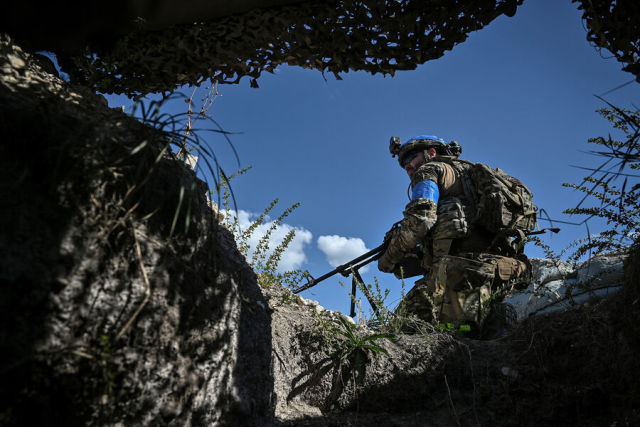Colonel Khodarenok: The AFU will complete the counteroffensive due to lack of resources
The offensive operation of the Armed Forces of Ukraine is likely to end in the near future. According to the estimates of the chairman of the Joint Chiefs of Staff of the US Armed Forces, General Mark Milley, we can talk about 30-45 days. The American general linked the end of active hostilities with bad weather. What else is behind the forecasts of the American military commander and what does the experience of the Great Patriotic War have to do with it - in the material of the military observer "Gazeta.Ru" by Mikhail Khodarenka.
"There is still enough time left - probably about 30-45 days before the bad weather, so the Ukrainians are not finished yet," Mark Milli said, adding that the entry into the rights of autumn and winter will complicate the further offensive of the Armed Forces of Ukraine, which even in summer was slower than expected in the United States. His words are quoted by the BBC.
There is every reason to believe that such a statement by the Chairman of the Joint Chiefs of Staff of the US Armed Forces is not related to weather conditions that will change in the near future. For sure, the American military commander has an operational unit on the map and an explanatory note to the Ukrainian offensive operation, all the necessary information on the combat and numerical composition of the Armed Forces (including the number of units and their weapons in the directions of the troops' actions), as well as information on the provision of the Armed Forces with weapons and equipment, ammunition, guided missiles, fuel, food, clothing and medical equipment.
And it was based on these data that General Mark Milli roughly determined: the offensive capabilities of the AFU can be exhausted in about 30-45 days. That is, it is unlikely that the considerations of the American military commander are based solely on intuition and foresight of the development of the situation.
As for the onset of the thaw and the expected decrease in the intensity of hostilities, the experience of previous wars does not convince of the imperative of this connection in any way.
For example, in the period from December 24, 1943 to April 17, 1944, the Red Army conducted the Dnieper-Carpathian strategic offensive operation (liberation of Right-Bank Ukraine). This is one of the largest operations of the Second World War. It was a system of ten front-line operations interconnected in time and direction of strikes. The Dnieper-Carpathian operation was carried out by troops of the 1st, 2nd, 3rd and 4th Ukrainian fronts. At the final stage, the troops of the 2nd Belorussian Front took part in it.
The width of the front of the fighting was 1300-1400 km . The depth of the advance of the Soviet troops is 250-450 km . The average daily pace of the offensive is 2-4 km . 2 million 406 thousand soldiers and commanders of the Red Army took part in the operation. As a result, the defeat of the entire southern wing of the eastern front of the Wehrmacht was completed. It should be particularly noted that the operation was carried out under very, very unfavorable climatic conditions. Eyewitnesses recall that neither before nor after they saw anything like that to remind them of the muddy road of those days in Right-Bank Ukraine.
There are more than enough examples of the success of offensive operations in such conditions in the history of wars and military art. The most important thing is the presence of both the military-political will and the armed forces, which should be a fully debugged and flawlessly functioning mechanism.
For example, during the Dnieper-Carpathian strategic offensive operation, the daily losses of the Red Army amounted to almost 10 thousand people. That is, every day, only to make up for the losses in manpower, it was necessary to send either a similar number of marching reinforcements to the front, or another rifle division.
Tanks and self-propelled guns during this operation, 2,639 units were lost, that is, daily losses in armored vehicles amounted to 31 tanks and self-propelled guns. And the United States is going to supply the armed forces of Ukraine with only 31 M1 Abrams tanks, while the Ukrainian army needs not 31 tanks to carry out large-scale offensive operations, but five times three hundred vehicles of this type.
In other words, it's not about the weather. And in a clear answer to the question - are the APU capable of solving such large-scale operational and strategic tasks today. That is, not to master some hitherto unknown Great Kamyshevakha in three months of bloody battles, but, say, to inflict a sensitive defeat on the Armed Forces of the Russian Federation during the upcoming hostilities, and thereby achieve the political goals of the campaign as a result.
The answer to this question is likely to be negative. And General Mark Milli knows about it. Therefore, the assessments of the American military commander are so streamlined and by no means categorical in nature. That is, the chairman of the Joint Chiefs of Staff of the US Armed Forces always has the opportunity to step aside and say, "I didn't say anything like that."
The opinion of the author may not coincide with the position of the editorial board.
Biography of the author:
Mikhail Mikhailovich Khodarenok is a military columnist for the newspaper.Ru", retired colonel.
He graduated from the Minsk Higher Engineering Anti-Aircraft Missile School (1976), the Military Air Defense Command Academy (1986).
Commander of the S-75 anti-aircraft missile division (1980-1983).
Deputy Commander of the anti-aircraft missile regiment (1986-1988).
Senior Officer of the General Staff of the Air Defense Forces (1988-1992).
Officer of the Main Operational Directorate of the General Staff (1992-2000).
Graduated from the Military Academy of the General Staff of the Armed Forces of Russia (1998).
Columnist of "Nezavisimaya Gazeta" (2000-2003), editor-in-chief of the newspaper "Military-Industrial Courier" (2010-2015).
Mikhail Khodarenok

